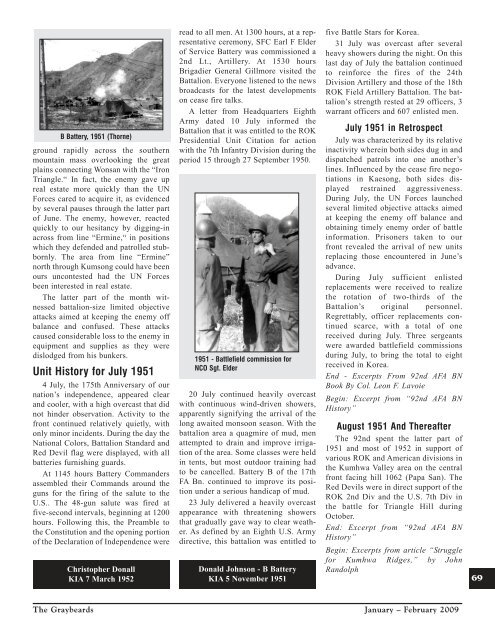Jan/Feb 2009 - Korean War Veterans Association
Jan/Feb 2009 - Korean War Veterans Association
Jan/Feb 2009 - Korean War Veterans Association
You also want an ePaper? Increase the reach of your titles
YUMPU automatically turns print PDFs into web optimized ePapers that Google loves.
B Battery, 1951 (Thorne)<br />
ground rapidly across the southern<br />
mountain mass overlooking the great<br />
plains connecting Wonsan with the “Iron<br />
Triangle.“ In fact, the enemy gave up<br />
real estate more quickly than the UN<br />
Forces cared to acquire it, as evidenced<br />
by several pauses through the latter part<br />
of June. The enemy, however, reacted<br />
quickly to our hesitancy by digging-in<br />
across from line “Ermine,“ in positions<br />
which they defended and patrolled stubbornly.<br />
The area from line “Ermine”<br />
north through Kumsong could have been<br />
ours uncontested had the UN Forces<br />
been interested in real estate.<br />
The latter part of the month witnessed<br />
battalion-size limited objective<br />
attacks aimed at keeping the enemy off<br />
balance and confused. These attacks<br />
caused considerable loss to the enemy in<br />
equipment and supplies as they were<br />
dislodged from his bunkers.<br />
Unit History for July 1951<br />
4 July, the 175th Anniversary of our<br />
nation’s independence, appeared clear<br />
and cooler, with a high overcast that did<br />
not hinder observation. Activity to the<br />
front continued relatively quietly, with<br />
only minor incidents. During the day the<br />
National Colors, Battalion Standard and<br />
Red Devil flag were displayed, with all<br />
batteries furnishing guards.<br />
At 1145 hours Battery Commanders<br />
assembled their Commands around the<br />
guns for the firing of the salute to the<br />
U.S.. The 48-gun salute was fired at<br />
five-second intervals, beginning at 1200<br />
hours. Following this, the Preamble to<br />
the Constitution and the opening portion<br />
of the Declaration of Independence were<br />
Christopher Donall<br />
KIA 7 March 1952<br />
read to all men. At 1300 hours, at a representative<br />
ceremony, SFC Earl F Elder<br />
of Service Battery was commissioned a<br />
2nd Lt., Artillery. At 1530 hours<br />
Brigadier General Gillmore visited the<br />
Battalion. Everyone listened to the news<br />
broadcasts for the latest developments<br />
on cease fire talks.<br />
A letter from Headquarters Eighth<br />
Army dated 10 July informed the<br />
Battalion that it was entitled to the ROK<br />
Presidential Unit Citation for action<br />
with the 7th Infantry Division during the<br />
period 15 through 27 September 1950.<br />
1951 - Battlefield commission for<br />
NCO Sgt. Elder<br />
20 July continued heavily overcast<br />
with continuous wind-driven showers,<br />
apparently signifying the arrival of the<br />
long awaited monsoon season. With the<br />
battalion area a quagmire of mud, men<br />
attempted to drain and improve irrigation<br />
of the area. Some classes were held<br />
in tents, but most outdoor training had<br />
to be cancelled. Battery B of the 17th<br />
FA Bn. continued to improve its position<br />
under a serious handicap of mud.<br />
23 July delivered a heavily overcast<br />
appearance with threatening showers<br />
that gradually gave way to clear weather.<br />
As defined by an Eighth U.S. Army<br />
directive, this battalion was entitled to<br />
Donald Johnson - B Battery<br />
KIA 5 November 1951<br />
five Battle Stars for Korea.<br />
31 July was overcast after several<br />
heavy showers during the night. On this<br />
last day of July the battalion continued<br />
to reinforce the fires of the 24th<br />
Division Artillery and those of the 18th<br />
ROK Field Artillery Battalion. The battalion’s<br />
strength rested at 29 officers, 3<br />
warrant officers and 607 enlisted men.<br />
July 1951 in Retrospect<br />
July was characterized by its relative<br />
inactivity wherein both sides dug in and<br />
dispatched patrols into one another’s<br />
lines. Influenced by the cease fire negotiations<br />
in Kaesong, both sides displayed<br />
restrained aggressiveness.<br />
During July, the UN Forces launched<br />
several limited objective attacks aimed<br />
at keeping the enemy off balance and<br />
obtaining timely enemy order of battle<br />
information. Prisoners taken to our<br />
front revealed the arrival of new units<br />
replacing those encountered in June’s<br />
advance.<br />
During July sufficient enlisted<br />
replacements were received to realize<br />
the rotation of two-thirds of the<br />
Battalion’s original personnel.<br />
Regrettably, officer replacements continued<br />
scarce, with a total of one<br />
received during July. Three sergeants<br />
were awarded battlefield commissions<br />
during July, to bring the total to eight<br />
received in Korea.<br />
End - Excerpts From 92nd AFA BN<br />
Book By Col. Leon F. Lavoie<br />
Begin: Excerpt from “92nd AFA BN<br />
History”<br />
August 1951 And Thereafter<br />
The 92nd spent the latter part of<br />
1951 and most of 1952 in support of<br />
various ROK and American divisions in<br />
the Kumhwa Valley area on the central<br />
front facing hill 1062 (Papa San). The<br />
Red Devils were in direct support of the<br />
ROK 2nd Div and the U.S. 7th Div in<br />
the battle for Triangle Hill during<br />
October.<br />
End: Excerpt from “92nd AFA BN<br />
History”<br />
Begin: Excerpts from article “Struggle<br />
for Kumhwa Ridges,” by John<br />
Randolph<br />
69<br />
The Graybeards<br />
<strong>Jan</strong>uary – <strong>Feb</strong>ruary <strong>2009</strong>

















